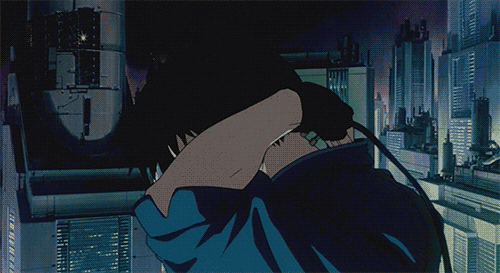The Ghost In The Shell live-action remake recently released a series of teasers to start generating buzz for its 2017 release, but it’s left us with a lot more questions than answers.
These ten-second clips don’t give us much to work with. As someone who is a big fan of the original animated film, I kept asking myself “what am I supposed to be looking at here?” and honestly, I still have no idea. These teasers are supposed to offer us a sneak peek inside the movie’s dark, sleek world but there’s no real plot reveals or build-up generated by these slow-moving, mostly silent shots. Visual analysis aside, this new series of trailers has also given us our very first look at Scarlett Johansson as the film’s heroine.
Johansson’s controversial casting in the lead role brought a lot of scrutiny from the Asian American community and fans of the original franchise alike. This film became another act of whitewashing Asian narratives and an erasure of Japan’s cultural history. Let’s break this down with a series of insightful tweets from comic writer Jon Tsuei:





The original manga and the animated movie are a powerful meditation on the body and consciousness in Japan’s postmodern world. While, yes, this theme of technology and humanity has been the subject of science fiction movies for years, Ghost In The Shell is a very important film in the greater context of Japan’s postwar history. The whole story takes place Japan, for Christ’s sake, and the characters all had Japanese names — Scarlett’s “Major” was originally called Motoko Kusanagi until directors made the change.
Steve Paul, the film’s (white) producer, spoke to Buzzfeed as criticism over movie grew. Paul, of course, defended his casting choices, claiming that the film’s setting is an “international world.” Why, then, are almost all of the principal characters white? Characters of color (including GURLSTALK founder Adowa Aboah) seem like an afterthought, and in the first teaser, featuring a geisha, Japanese aesthetics appear to be exploited for style while cultural importance is lost.
While people like Tsuei continue to argue that this film needs to exist in a Japanese context, Paul did not share that view. “I don’t think it was just a Japanese story. Ghost in the Shell was a very international story, and it wasn’t just focused on Japanese; it was supposed to be an entire world.”

Yes, in the U.S. and all over the world there has been revolutionary technological growth and development and new questions are being raised about the use of technology in our daily lives. However, Paul’s “international” assumption is wrong and he needs to re-visit the context in which the original manga was created.
It’s one thing if this movie was completely reshaped to fit into American culture, was set in America, and characters had American names, but this is not the case. While Scarlett’s character name may have altered, the other characters retain their original names whether they are actually Japanese or not. America has had its own unique relationship to globalization and the tech boom, so why did the movie’s creators feel the need to rip-off parts of Japan’s history under the very questionable veil of “international”?

Although Asian Americans account for five percent of the US population, Asian Americans make up only 2% of people and characters shown on television. In the movie world, Asian actors rarely receive mainstream visibility — when they do they usually play villains or stereotypes. If the producers of this film really wanted to make a respectful re-boot of this franchise, they would’ve cast these roles accordingly. But they didn’t. They chose profit over representation, as Hollywood has continued to do time and time again.
Scarlett Johansson, just by name recognition alone, will bring in millions for this film. Don’t get me wrong, I’ve got nothing against ScarJo, but this is not the right role for her. Paramount went as far as try to make her appear more Asian (yellow-face with no success) rather than simply hire a Japanese actress to fill the role.
So yeah, these new teasers are out, but we’re not exactly hanging onto our seats in anticipation for the film’s release next year. Sure the visuals are kinda of cool but a couple of glitchy teasers shouldn’t sweep all of this whitewashing Japanese cultural erasure under the rug. When will Hollywood finally get it right?
Photo: Ghost in the Shell
More from BUST
Disney, Please Don’t Whitewash ‘Mulan’ We’re Begging You
Ava DuVernay’s ‘A Wrinkle In Time’ Has Found Its Leads — And They’re Almost All People Of Color

